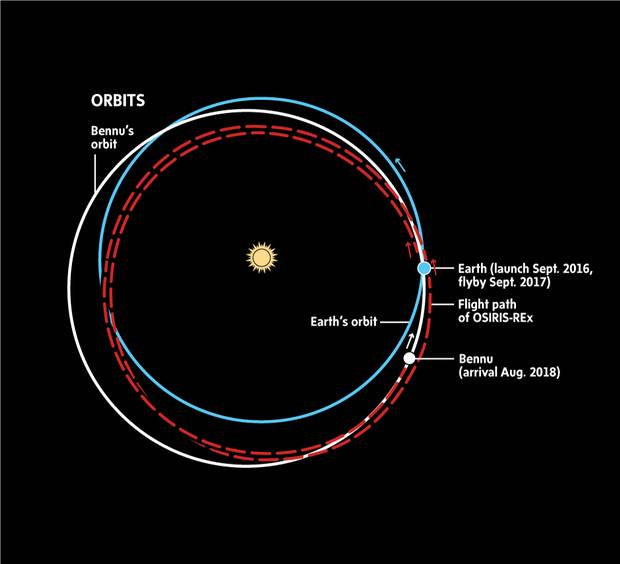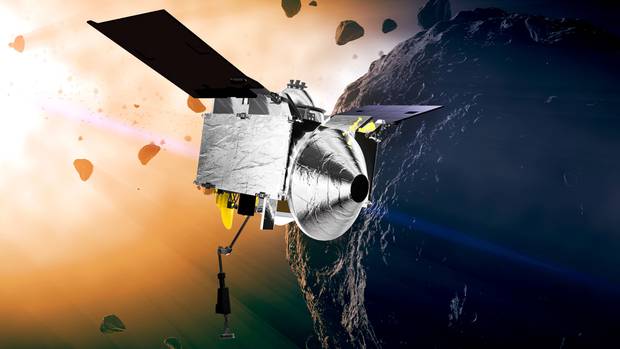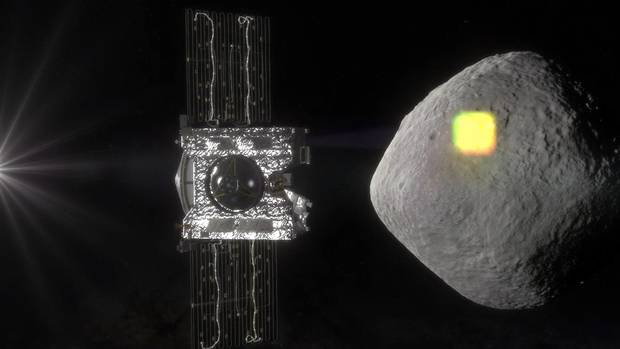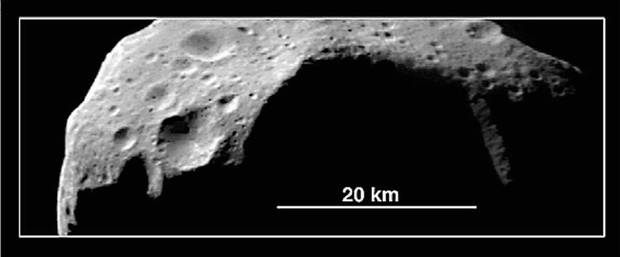A PIECE OF THE ACTION
Even by human standards, the asteroid known as Bennu is a small world. Measuring barely 500 metres across, it brings to mind the fictitious home of the Little Prince who could watch the sunset over and over again simply by moving his chair.
But little Bennu is sitting on some big questions that scientists are keen to answer, not the least of which is how we might best protect ourselves from asteroids that threaten to smack into Earth and disrupt human civilization.
The quest to understand what asteroids can tell us has led directly to OSIRIS-REx, a daring robotic explorer led by the U.S. National Aeronautics and Space Administration and the University of Arizona. Canada is also participating, and has provided a lidar system that can scan Bennu with centimetre-scale precision.
"We didn't have time to get it wrong," says Mike Daly, an associate professor of space engineering at Toronto's York University who helped to lead the instrument's development on a challenging timeline.
The proof that they got it right, he adds, is that the instrument, together with the rest of OSIRIS-REx is now sitting on the launch pad ready to lift off as early as 7:05 p.m. ET on Thursday.
The probe's mission is not merely to visit Bennu, but to scoop up some of it to bring back home. If it succeeds, then Canada will have a piece of asteroid to call its own.
BRICKS IN SPACE
Asteroids are the bricks from which rocky planets such as Earth were built. Like time capsules adrift in an interplanetary ocean, hundreds of thousands of asteroids ply our solar system in the broad gap between the orbits of Mars and Jupiter, where they occasionally collide and make even more asteroids.

TRISH McALASTER/THE GLOBE AND MAIL (SOURCE: NASA)
Some, like Bennu, have been jostled into orbits much closer to us. These flying rubble piles present both a risk and an opportunity. When they collide with Earth, asteroids can wreak havoc on a regional or even global scale. At the worst, they can trigger a mass extinction, such as the impact that is thought to have bumped off the dinosaurs 66 million years ago.
Bennu is too small wipe out all of humanity, but it could help explain how we got here. It was first spotted in 1999 and rose to the top of the list of possible targets for an asteroid sample return mission. Scientists suspect it is a good model for the kinds of asteroids that rained down on Earth billions of years ago, delivering the building blocks of life.
Bennu's looks certainly belie this tantalizing possibility. It is as black as coal, reflecting only 4 per cent of the sunlight that falls on it. This is the hallmark of an object rich in carbon-based organic compounds. In other words, Bennu may look like a flying lump of coal, but a small piece of it would be as good as gold to planetary scientists trying to understand our origins.
BUILT FOR BENNU
Even before it leaves the ground, OSIRIS-REx has probably already won the title for the most elaborate NASA acronym ever devised. The name of the spacecraft, selected by principal investigator Dante Lauretta, stands for Origins-Spectral Interpretation-Resource Identification-Security-Regolith Explorer. Put it all together and it also pays homage to Osiris, the Egyptian god of the dead, resurrection and fertility – an apt résumé for what asteroids mean to us, both as potential bringers of doom and the cosmic fertilizer that may have once allowed life to gain a foothold on our planet.

TRISH McALASTER/THE GLOBE AND MAIL (SOURCE: NASA)
The spacecraft is a 6.2-by-3.2-by-2.4-metre box packed with instruments designed to reveal as much about at the chemical composition and history of Bennu as possible. That includes the OSIRIS-REx Laser Altimeter (OLA), the Canadian instrument built by Brampton, Ont.-based MacDonald Dettwiler and Associates and Optech, a company that specializes in laser survey systems. By reflecting laser light off a fast-moving mirror, OLA will be able to measure the distance to Bennu's surface 10,000 times each second, effectively turning it into a 3-D camera for mapping the irregularly shaped asteroid.
"It really allows us to blanket the whole asteroid and get a complete shape model," Dr. Daly says. "This is significantly better than anything like this that has flown before."
THE JOURNEY
Once launched, OSIRIS-REx is set to follow a spiralling path to Bennu, covering many hundreds of millions of kilometres although, at times, the asteroid is only a fraction of that distance from Earth.
The reason for the long and winding road comes down to having to exactly match the velocity and orbital trajectory of the spacecraft with that of the asteroid so the spacecraft can pull up alongside rather than simply zip past.

TRISH McALASTER/THE GLOBE AND MAIL (SOURCE: NASA)
After liftoff at Cape Canaveral, Fla., the spacecraft will make one full trip around the sun and meet up with Earth again in September, 2017. As it passes by, Earth's gravity will tug on the probe, changing its direction slightly and putting it on course for a rendezvous with Bennu in August, 2018.
As OSIRIS-REx draws nearer to its target, the mission will shift into high gear. No one has tried to orbit such a small body before. Mission controllers will start the rendezvous while the spacecraft is still two million kilometres away, using its thrusters to reduce speed and eventually ease into a tandem flight about five kilometres from Bennu. From there it will shift into a polar orbit around the asteroid at a distance of about one kilometre.

The OSIRIS REx probe is expected to reach the asteroid in 2018.
ARTIST’S CONCEPT FROM NASA’S GODDARD SPACE FLIGHT CENTER/CONCEPTUAL IMAGE LAB
A DUSTY WORLD
After OSIRIS-REx has achieved orbit, exploration of Bennu will begin in earnest. This will include not only scanning the surface with OLA but also taking high-resolution images and detailed gravity measurements to build up one of the most comprehensive profiles of an extraterrestrial body ever obtained.
While one camera combs Bennu's surface, a second will search for tiny moons – essentially large boulders that could be circling around the larger asteroid – and for signs of gases that Bennu may be venting into space. Among other things, OSIRIS-REx will study the Yarkovsky effect, in which a spinning asteroid can gradually change its own orbit through absorbing and reradiating solar energy. The data should help researchers make more accurate predictions of the movements of asteroids that could some day threaten Earth.
Meanwhile, other instruments aboard OSIRIS-REx will measure temperature differences on the surface of Bennu and look for the telltale signatures of surface minerals in infrared, visible and ultraviolet light.
During an exhaustive year-long survey, the key objective will be to locate the most promising place on the surface for OSIRIS-REx to capture a sample.
Bennu was chosen as a target partly because it spins relatively slowly, completing one rotation every 4.3 hours. Some smaller asteroids spin quickly enough to fling off loose surface material. In contrast, Bennu is likely to be covered in a fine powdery dust and small pebbles known as regolith.

OSIRIS-REx will use a Canadian-made laser to scan the asteroid’s surface.
ARTIST’S CONCEPT FROM NASA’S GODDARD SPACE FLIGHT CENTER/UNIVERSITY OF ARIZONA
TOUCH AND GO
"Sample return is really at the forefront of planetary exploration," Dr. Lauretta says as he describes the climax event of the OSIRIS-REx mission.
While it's great to study an asteroid up close, he notes, it's even better to bring one home and study it in the laboratory with instruments that are too large or sensitive to fit on a spacecraft.
My main scientist, Dante Lauretta, on why we want to bring a sample back to Earth. https://t.co/Nabd5KpStc
— OSIRIS-REx (@OSIRISREx) August 17, 2016
Several years ago, Japan attempted the same feat with its Hayabusa mission and, despite technical glitches, that spacecraft managed to return a microscopic quantity of asteroid dust. In contrast, OSIRIS-REx will need to bring back at least 60 grams to be declared a success, but science team members say they will be disappointed if they don't get much more than that – potentially as much as two kilograms.
To achieve this, OSIRIS-REx is equipped with a robotic arm and sampler head that will momentarily reach down and touch the surface of Bennu, rather like the bottom of a Pogo stick before it springs away. During the approximately five seconds of contact, the sampler will release a burst of nitrogen gas that should stir up regolith on Bennu's surface, causing dust and pebbles to rise into the sample collector.
After the spacecraft withdraws form Bennu, it will spin the sample to gauge how much it's collected. Once scientists are happy with their haul, the science mission is officially over and OSIRIS-REx will prepare to return to Earth.
SEALING THE DEAL
If all goes according to plan, the final act for OSIRIS-REx will be a two-year return trip that puts the spacecraft on a path to intercept Earth in September, 2023. During the journey, the precious sample gathered at Bennu will be in a sealed return capsule safely stowed on board.
As OSIRIS-REx approaches Earth, the sample return capsule is designed to be released from the main spacecraft and re-enter the atmosphere at a speed greater than 12 kilometres a second. As the capsule races toward the surface, air friction will slow it down until it can deploy a parachute, bringing it to a touchdown somewhere within the boundaries of the expansive Dugway Proving Ground, a U.S. military site in Utah.
Once retrieved, the asteroid sample is destined first for the Johnson Space Center in Houston in the sample facility that houses the Apollo lunar samples.
At that point, about a quarter of the sample will be made available for scientific study. Canada will receive 4 per cent of whatever amount has been collected. The remainder will be stored for future generations of researchers who may one day conduct experiments on the sampled material using tools and techniques that have yet to be invented.
Whatever comes out of OSIRIS-REx will inform future asteroid exploration, including human missions, as well as continuing efforts to build surveillance and defence systems against asteroid impacts. It also brings us one step closer to mining asteroids for their resources or simply corralling them and parking them in orbit around Earth for handy access.
TIMELINE
Close encounters: 25 years of asteroid chasing
Oct. 29, 1991: NASA's Galileo spacecraft makes the first flyby of an asteroid, 951 Gaspra, on its way to Jupiter.
Aug. 28, 1993: Galileo passes a second, larger, asteroid named 243 Ida and discovers that it is orbited by a small moon.
June 27, 1997: NEAR Shoemaker, a NASA mission, flies by 253 Mathilde, capturing the first close-ups of a carbon-rich asteroid.

Asteroid Mathilde, as seen by the Near Earth Asteroid Rendezvous spacecraft on June 27, 1997.
NASA/ASSOCIATED PRESS
July 29, 1999: A U.S. probe called Deep Space 1 passes within 26 kilometres of the tiny asteroid 9969 Braille.
Feb. 14, 2000: NEAR Shoemaker reaches the near-Earth asteroid 433 Eros and becomes the first spacecraft to orbit such a small body. The following year, it touches down on the surface, capturing close-ups along the way.
Nov. 2, 2002: NASA's Stardust spacecraft passes near the small asteroid 5535 Annefrank and discovers it could be a "contact binary" made up of two separate rocky chunks.
Nov. 19, 2005: Japan's Hayabusa mission makes contact with its target, asteroid 25143 Itokawa. An attempt to capture a sample goes awry, but some asteroid dust is kicked into the spacecraft's collection mechanism and returned to Earth in 2010.
Sept. 5, 2008: Europe achieves its first asteroid encounter when the Rosetta spacecraft glides by the small asteroid 2867 Steins on its way to a comet.
July 10, 2010: Rosetta observes the large asteroid 21 Lutetia from a distance.
July 16, 2011: NASA's Dawn spacecraft enters orbit around the second largest asteroid, Vesta, and begins a year-long study.
Dec. 13, 2012: A Chinese lunar probe named Chang'e 2 manages to make a close pass of the asteroid 4179 Toutatis as it whizzes by the Earth-moon system.
March 6, 2015: Dawn reaches Ceres, the solar system's largest asteroid, now called a dwarf planet.
Sept. 8, 2016: The OSIRIS-REx asteroid sample return mission is set for launch.
Ivan Semeniuk is The Globe's science reporter.
Follow Ivan Semeniuk on Twitter: @IvanSemeniuk
SEMENIUK ON SPACE: MORE FROM THE GLOBE AND MAIL
Ivan Semeniuk explains importance of Juno probe’s approach to Jupiter
1:40







